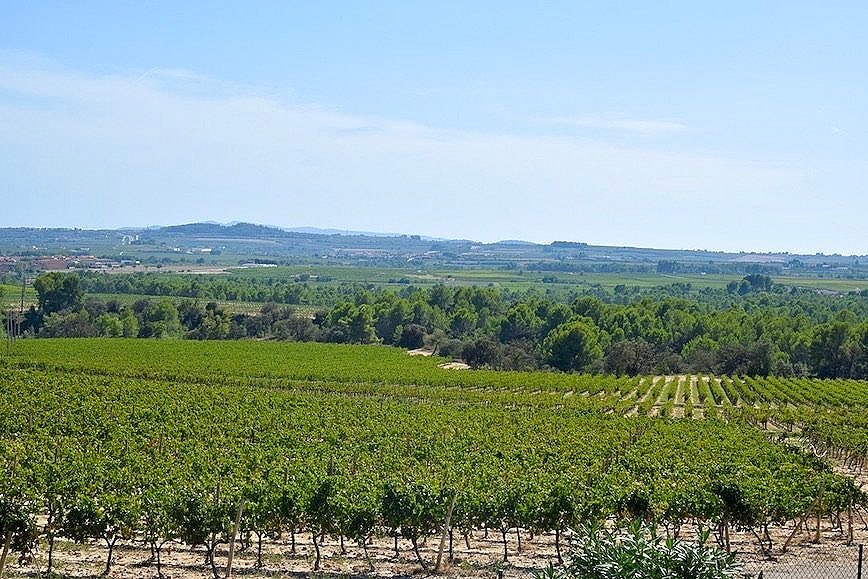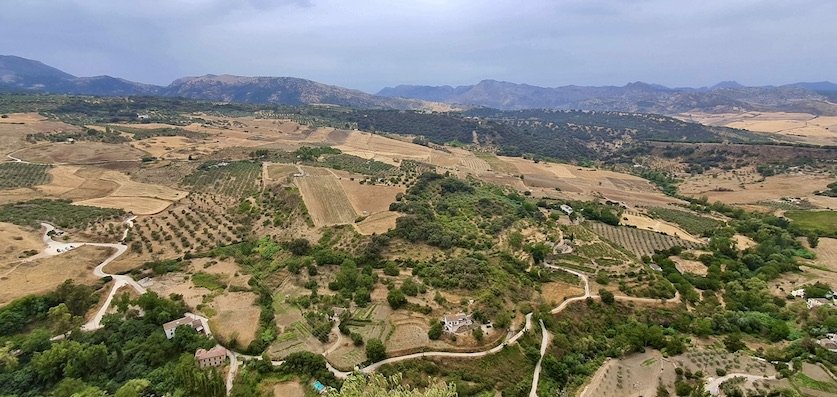THE SPAIN WINE REGIONS

Vineyards in Penedès, Catalonia
Photo source: Winekeller
Select a Spanish wine region for your next wine tour:
Which Spanish wine regions to explore:
Spain is the 3rd largest producer of wine (after France and Italy) and has the largest land area dedicated to vineyards in the world. It has a long and complex history, with a single nation only coming together in the 15th century and it similarly has a very long winemaking tradition. However, Spain has been something of a late starter in the ‘modern’ wine industry.
This is now changing and Spain is known for producing incredibly diverse and dynamic wines today, with new wine regions emerging, old indigenous grape varieties thriving, new wine styles developing and new producers entering the scene!
Wine map of Spain:
Wine is made all over Spain and there are approximately 70 Spanish DOs (Denominación de Origen) - see below - spread over the different geographic regions.
The different Spanish wine regions are incredibly diverse and there is a huge range of very different wines - much of this is due to climate and altitude. Spain is a land of extremes, with very hot summers and cold winters. It is extremely hot and dry in the south and in the interior, but cooler and wetter in the north and northwest.
See here for a full breakdown of the different Spanish wine regions and their respective DOs.
Spanish wine grapes
Spain is unusual in that almost 45% of all land under vine is planted with just 2 grape varieties - red Tempranillo and white Airén (mostly planted in La Mancha for brandy production). Garnacha (Grenache), Bobal and Viura (Macabeo) are also popular grape varieties.
Spain has some 600 native grape varieties and there is a growing trend towards (re)introducing these by innovative producers and winemakers. However, in reality, only something like 20% of these are used for regular wine production.
Some regions have specific grape varieties, a good example being Albariño in the region of Galicia in north-west Spain (Alvarinho in Portugal, just over the border), where the climate is much cooler and damper than in other Spanish wine regions and the dominant wine style is fresh, crisp white wines.
Spanish wines
A country with such an extensive wine tradition as Spain has to have many different wine types.
Red wines, white wines and rosé wines are produced in all of the wine making areas of Spain. Due to the challenging climate and older vines, the Spanish crops usually yield much smaller quantities of grapes than other regions across the world, but its wines are highly-concentrated and refined. Also, some 90% of Spanish vineyards lie at a higher altitude than in France and this accounts for the relative freshness of Spanish wines.

The dry arid landscapes of southern Spain in Andalucía
Source: Winekeller
Spanish wine types - the Spanish DO sytem
Spain’s DO quality classification system (Denominación de Origen) is arguably less complex than that of France or Italy:
Vino de Mesa: basic table wine made in unclassified vineyards, no vintage
Vino de la Tierra: equivalent of the French ‘vin de pays’, a table wine, but of a defined geographical origin - shows vintage and grape variety (the new EU ‘IGP’ classification is gradually replacing this - there are about 40 Spanish IGPs today)
DO (Denominación de Origen): wines from a specific geographical region made according to defined rules (the exception is Spanish Cava sparkling wine, which is a DO but defined by winemaking method, rather than region). There are over 70 different DOs today
DOCa (Deonominación de Origen Calificada): top classification - for Rioja and Priorat
DO Pago/Calificada: unique, top-quality single-estate vineyards
The top Spanish DOs
DO Jerez - Andalucía
DO Jumilla - Murcia
DO Malaga - Andalucía
DO Penedes - Cataluña
DOCa Priorat - Cataluña
DO Rias Baixas - Galicia
DO Ribera del Duero - Castilla Y León
DOCa Rioja - La Rioja
DO Tacoronte Acentejo - The Canary Islands
Best Spanish red wine - Spanish Rioja
The best red wine from Spain - or at least its most famous wine - and it has been for over 150 years - is Spanish Rioja. The Rioja region has perfect conditions for producing very fine wines and its classic red wines are revered the world over.
Tempranillo is by far the most important grape variety for Spanish Rioja, planted in over 80% of Rioja vineyards and it can be blended with Garnacha (Grenache). Red Rioja is produced in the classic styles, Crianza, Reserva and Gran Reserva, depending on the amount of time the wine has aged.
Spanish sparkling wines
It’s impossible not to mention Spanish wine without referencing its famous sparkling wine and Spain’s answer to Champagne, Spanish Cava, one of its most famous exports. 95% of Cava is produced in the Spanish wine region of Catalonia, around the wine capital of Sant Sadurni d’Anoia in Penedès.
Cava is produced in the same way as Champagne, but the grapes are very different - with the Macabeo grape variety dominating most Cava blends. The Cava industry is similarly dominated by 2 major players - and competitors - Codorníu and Freixenet.
Spanish sherry
Another famous export, which we absolutely need to include here is Spanish sherry, produced in the Andalucía wine region, around the tourism magnet of the Costa del Sol.
Andalucia is the oldest wine producing region in Spain and the fortified wine known as sherry today, can only be produced in the DO region of Jerez. Sherry comes in a wide range of styles, from the light Manzanilla and Fino wines through to the darker, richer Amontillado and Oloroso sherries.
The Cava capital in Penedès, Catalonia
One of the 2 major Cava producers, Codorníu
Spanish sherry
Planning your Spanish wine tour
Spain's La Sagrada Família in Barcelona
Spain is one of Europe’s most popular countries to visit, mainly because there is something for everyone!
It’s diverse heritage means you can visit and experience a wealth of different architecture and sights, from the prehistoric period to the ultra-modern, with the strong Roman and Moorish influence in between. There are lots of World Heritage Sites to visit including the spectacular Alhambra in Granada and the equally spectacular La Sagrada Família in Barcelona.
Cities such as the capital Madrid, Barcelona, Bilbao, Valencia, Seville and Malaga offer the visitor a superb choice of history, art, culture, fine-dining, night-life, glamour and shopping and the countryside offers amazing sport and outdoor activity opportunities as well as of course, incredible scenery.
Spain is a country where you can immerse yourself in tradition and culture, known for its gastronomy, its wines of course and its incredible zest for life, with its many festivals and fiestas. Its beautiful Mediterranean and Atlantic coastlines, including the varied coastlines of the Balearic Islands and the Canary Islands offer hundreds of miles of coastal areas, which are home to many of the most highly-rated beaches in Europe.
The beautiful Alhambra, Granada - Source: Winekeller
What to eat in Spain
Spain has an incredibly rich food culture and trying the traditional Spanish dishes is a must when in Spain! There are common foods and dishes you can find throughout the country, but each Spanish region also has its own distinct specialties.
Spain is the world’s largest producer of olive oil, so this and olives, feature prominently in Spanish cooking. Garlic is used regularly along with herbs and spices including saffron, pimento, oregano, rosemary, and parsley. Chicken and pork are the feature in many dishes, along with a large variety of fish and seafood.
Eating is a very social affair in Spain, not to be hurried but to be savoured and enjoyed. Tapas are a core element of the Spanish food scene and are basically small dishes served as appetisers or snacks. Pintxos is a popular type of tapas found in the northern Spanish regions.
Note that lunch in Spain is often eaten around 2pm and is the main meal of the day. Dinner is lighter and later, maybe around 9-10pm.
A typical Spanish market selling Jamón Ibérico - Source: Winekeller
Traditional dishes and specialities:
Paella - A well-known and much-loved Spanish rice dish, originating in Valencia but found all across Spain - can be made with meat or seafood and cooked in large, round paella plates
Jamón Ibérico (Spanish ham) - a cured ham which must be made from black Iberian pigs
Patatas Bravas - crispy potatoes covered in a spicy paprika sauce and aioli – often served as a tapas dish
Croquettes - often served as a warm tapas - a fried ball of bechamel sauce, mixed with other ingredients like ham, fish or vegetables
Spanish Chorizo - fermented, cured pork sausage, seasoned with spices including smoked paprika, and sometimes garlic - originates in the Iberian peninsula
Roast sucking pig (Cochinillo) - succulent meat, tender & crispy skin and a thin layer of fat
Tortilla Española (Spanish tortilla) - one of the most popular dishes in Spain - made with just eggs and potatoes, but other ingredients are often added, eg chorizo, peppers, tomatoes
Gambas al Ajillo - garlic prawns - very popular across Spain
Grilled Octopus (pulpo) - served with paprika and olive oil - a popular tapas dish
Padrón peppers - small green peppers (sometimes very spicy), blistered in olive oil and served with salt - a popular tapas dish
Churros - a very popular Spanish snack - ropes of fried dough, rolled in cinnamon and sugar
All of this, in addition to its enviable climate, makes Spain a mecca for millions of tourists every year.
Visit Spain’s official tourism website for more information to help you plan your trip.
Also see this Spain tourist guide and ideas for the top 10 things to see and do in Spain!
Spanish wine language
Vino blanco - White wine
Vino tinto - Red wine
Vino rosado - Rosé wine
Seco - Dry
Dulce - Sweet
Espumoso - Sparkling
Crianza - wine aged min 2 years (at least 6 months in oak)
Reserva - wine matured for a specific period
Gran Reserva - aged min 18-24 mths in oak, 36-42 mths in bottle
Pago - Vineyard
Bodega - Winery







